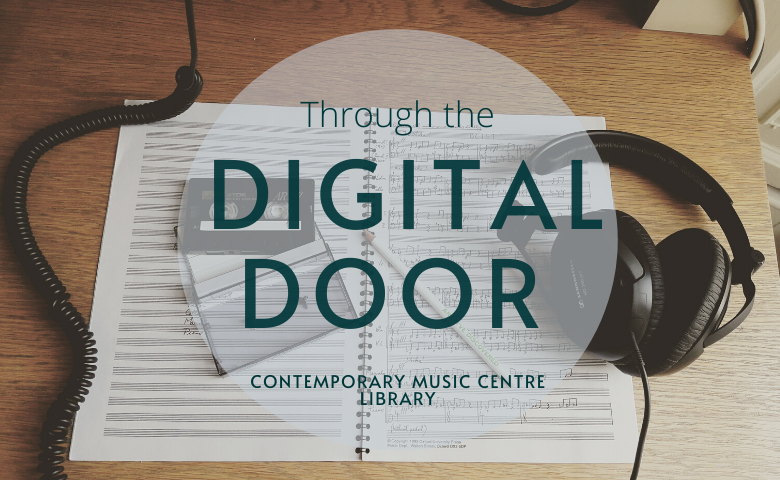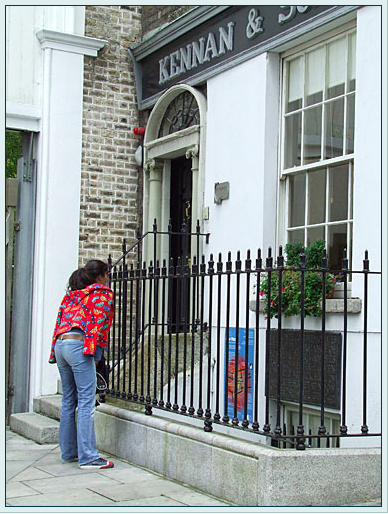Through the Digital Door: Electroacoustic and mixed-media works in CMC's Library
A large portion of CMC's vast catalogue is made up of electroacoustic, electronic and mixed-media works, and many of the composers represented by CMC specialise in this area of composition. This week's Through the Digital Door focuses on a small number of these works.
Roger Doyle: The Electrification of the Night (2018/2019)
Often described as 'the Godfather of Irish electronica', Roger Doyle has a vast catalogue of electronic music. His most recent release The Electrification of the Night, was released in May 2019.
Read/listen to an interview with Roger Doyle by CMC's Jonathan Grimes in July 2019 here.
Fergal Dowling: Spoils I. Unearths (2016)
This work was premiered in April 2016 in Smock Alley Theatre, Dublin at Music Current Festival. This is the first movement in a five-movement work.
Spoils was inspired by Robert Graves’ assertion that European cultural archetypes are encoded in a shared mythology, and by JP Mallory’s description of the origins and spread of Indo-European languages. Graves contends that our inherited European languages and customs conceal a common belief system that can be deciphered through the study of poetry, and Mallory’s approach to comparative linguistics affirms a similar understanding. In Spoils I have attempted to model these parallel actions of interpretation and misinterpretation, of excavation and simultaneous reburial – like the Spoils from a mineshaft burying the surrounding landscape while exposing the earth’s interior. In each of the five movements the instrumental and pre-recorded vocal parts become overlaid by themselves; each moment, in its own becoming, exhumes fragments of its earlier self and, at the same time, reinters itself beneath its own remains.
Karen Power: is this on? (2019)
This work was commissioned by RTÉ lyric fm and was premiered at Cork Midsummer Festival in Cork City Gaol. This work was commissioned to mark one of Ireland's earliest radio broadcasts, the sound of cartwheel on cobbles from Cork City Gaol in 1927. This commission also pays tribute to the significant contributions by women to Ireland's turbulent history in the early twentieth century.
is this on? combines field recordings recorded by Karen from all over the world, RTÉ lyric fm archival materials + inaudible sounds from Cork City Gaol itself. We together will move between real and imaginary worlds, times and spaces. We are here in this beautiful space, which creates one unique listening environment. Radio audiences are in a variety of other spaces surrounded by other contexts - whether they be passing traffic in a car, the kettle boiling in the kitchen. This piece is designed to trigger sonic connections with these known and unknown spaces. To allow you time to dream in and through sound. To bring you on a journey through Ireland's past voices and times. To connect you to each other and at the same time highlight our individuality in the way you receive sound. Each of our listening experiences are largely governed by our unique context, or memory of a place, a time, a sound and these unconsciously direct our hearing of everything. All I am doing as the composer of this piece is choosing to highlight specific sounds that surround us all of the time and that have some connection with our history as Irish people. I hope that through these decisions you can embark on one of many potential sonic trips. The music is designed to first root us in this stunning gaol space and then gradually move away into a realm of real but reimagined spaces. Every so often I remind you of where you started from, but even this grounding changes based on where else we’ve been.
Anna Murray: Rndr7 (Moon) (2020)
Rndr7 (Moon) is part of Anna Murray's recent release Rndr II, which is her second album of experimental ambient electronic music. The four works on this album are recorded improvisations based on a random selection of samples of sounds, ranging from field recordings to early gramophone recordings and instruments.
The tracks were chosen to capture the sonic impression of life in Tokyo – the constant pull between city noise and quiet spaces, between reserve and obsession, between the preservation old traditions and the most modern city in the world.
Jennifer Walshe: Hildegard von Bingen: In Principio Omnes, from Ordo Virtutum (2019/2020)
This work is part of Jennifer Walshe's 2020 release A Late Anthology of Early Music Vol. 1: Ancient to Renaissance.
For my sins, I spent many years teaching the history of Western music to undergraduate students. I taught the “grand tour” - two millennia of music history crammed into three terms. The party line in the textbooks I was required to teach from was clear - after a brief detour to Ancient Greece, Western music unfolded from the voice, evolving with logic and clarity, from plainchant to organum and the motet, polyphonic counterpoint and beyond, successive genres building on and fractally expanding what came before.
Dadabots, the duo of machine learning specialists CJ Carr and Zack Zukowkski, trained their neural network Sample-RNN on hours of a capella recordings of my voice, producing 841 files over 40 generations of training. When CJ and Zack sent me the files, I was struck deeply by how it felt to listen to the network learning - the early files consisting of long notes and glitchy errors gradually giving way to moments of bizarre melody, whistles and washes of white noise before the sound of my own voice began to emerge. I was struck by the parallels with the party line of my music history days. In A Late Anthology, I map the development of the network’s understanding of my voice onto the history of early Western music. Machine learning is used as a filter to listen to the history of early Western music; Western music history is used as a filter to listen to machine learning. In combination, they produce a new alternative tradition, a proposal for a different way of thinking about, listening to and making a history of Western music.
Matthew Whiteside: Unda Malacia (2016)
This work was composed for Rosanna Lee's exhibition at the RSA New Contemporaries in March 2016.
Unda Malacia uses water as its source material to create an uneasy meditative experience.
Enda Bates: Pond Studio (2016)
This work is the third track from Park Sounds, a collection of works composed during i-Park's 2016 Composers + Musicians Collaborative Residency.
This soundscape was based on two field recordings made around midnight outside my cabin; the Pond Studio of the title. The dominant sounds were that of crickets and frogs, accompanied by distant cars and the rumble of jet planes overhead. All of the additional sounds were generated from these two recordings, with a particular focus on the tonality and rhythmic call and response of the ever-present crickets. This piece is dedicated to Joanne Paradis and Ralph Crispino Jr.
Linda Buckley: Immersia (2008)
Immersia is a three-movement work, premiered in April 2011 at the Lab for Electronic Arts and Performance in Berlin. This work was released by Ergodos in 2011.
From the CMC Archive: 2006
To celebrate CMC's twentieth anniversary in 2006, The Contemporary Music Centre created an outdoor music trail in the Old City area of Temple Bar, Dublin. The three new pieces of music were specially commissioned by the Contemporary Music Centre in association with Temple Bar Cultural Trust’s 2006 Diversions Festival with funding from Dublin City Council.
The three works were Ailís Ní Riain's Streetsong, Seán Taylor of Softday's Alignments and Siobhán Cleary's Eblana Civitas. Read more about these three works and listen to a podcast about this Music Trail on CMC's website here.


